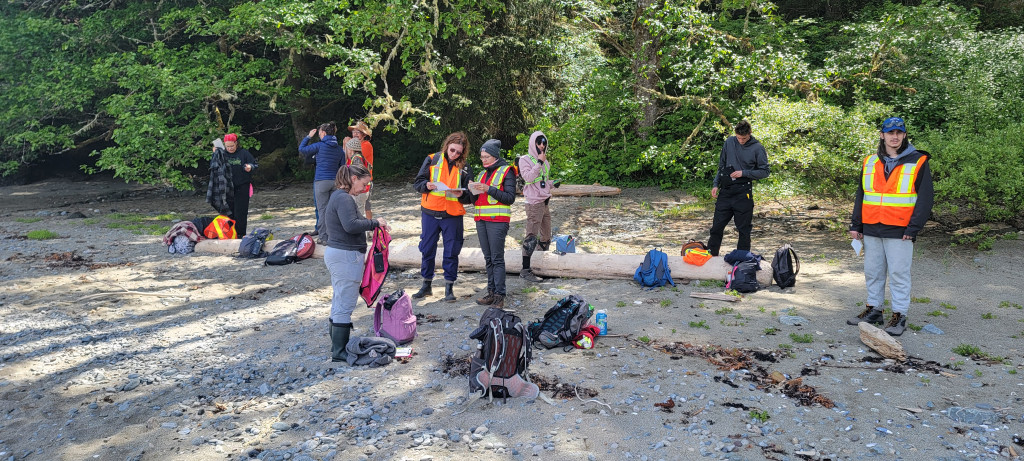Camosun College's Archaeology Field Assistant program reignited Carla Rafaela Monteiro's natural curiosity and passion for science and the humanities.

Carla Monteiro in the centre wearing a red crew vest - Archaeology Field Assistant program
A highlight for Carla was a visit to Kiixin, the only known First Nations village with standing architecture on the west coast of Vancouver Island. Carla and her classmates learned about the three remaining big houses through a combination of Nuu-chah-nulth oral history, archaeology and personal reflection.
“Archaeology has always been one of my areas of interest. With a background in the humanities and having studied in a post-degree program at Camosun College, I am familiar with the quality of the college's programs and instructor,” explains Carla. “When I learned about the Archaeology Field Assistant program, I was very interested because I knew the applied learning would be of high quality. The dual certification through the college and the provincial Archaeology Branch, makes the program even more appealing.”
“The program is the perfect combination of theory and practice,"
Carla Rafaela Monteiro
The Archaeology Field Assistant certificate program was delivered over 10 days in May. It included a six-day field component on the west coast in partnership with Dr. Tommy Happynook from the Anthropology Department at the University of Victoria, and the Huu-ay aht Nation.
Hands-on learning in the field
Carla and the class headed to Bamfield to camp in Pachena Bay after three days of lectures, labs and local field trips.
“The field component gave me the opportunity to apply what we were learning in the territory of the Huu-ay-aht peoples,” adds Carla. “We were warmly welcomed and had the honour of learning directly from members of the Huu-ay-aht Nation.”
The field component was intended to resemble the conditions an Archaeological Field Assistant might encounter. The class experienced sunny days, rain, and cold. They found traces of bears and otters, walked extensively through terrains and trails, and shared a collective experience at the camp.
Students learned from Tommy Happynook about Culturally Modified Trees (CMT), a requirement of the certification training recognized by the Archaeology Branch. Tommy demonstrated stripping bark for weaving, which leaves long, triangular bark strips that are the most common feature recorded by archaeologists in the province.
“The program is the perfect combination of theory and practice. We had the opportunity to put into practice the various techniques and knowledge we acquired,” says Carla. “Each element was introduced in such a way that by the end, we were ready to survey an area on our own.”
Stephen Smith, a CMT expert with Huu-ay-aht Nation, took the class to see one of the more unusual examples of CMTs: canoes blanks. These logs or log sections are partially shaped canoes that are uncompleted. Students recorded the canoe blanks, associated stump features and created a site map.
Combining theory and practice
Discussions between the program, Tommy, and the Huu-ay-aht Nation’s lands department led to the creation of a small survey project to investigate the area behind Second Beach. The survey's objective was to evaluate the location as the nation makes decisions about future eco-tourism development. Students collected data to create maps, located and mapped several CMTs and took extensive fieldnotes.
“The field classroom dished up conditions that cannot be replicated on campus,” says Nicole Kilburn, Archaeology Field Assistant program leader. “Indigenization of education shouldn’t be novel but rather infused in teaching and learning experiences. Modelling this approach to learning is good for all students and puts Indigenization in action.”
On the last morning, students visited čaačaac̓iiʕas. This is the English name for Carnation Creek and is Tommy's family's territory. Students spent several hours mapping an extensive rock feature in the intertidal zone, likely the remains of a large stone fish trap.
“Students mapped the feature in teams to get the work done before the tide came in and demonstrated the skills and confidence that they had acquired,” adds Kilburn. “They could not have completed this work just seven days prior. Their pride and sense of accomplishment at doing this work was very obvious.”
Financial support by the Camosun College Foundation made the field component possible.
The next Archaeology Field Assistant certificate program will run in Summer 2025.
Contact information
Jonathan Ruhl
Marketing and Communications StrategistCamosun College
Additional Contact Info
Rodney Porter
Marketing and Communications
250-889-7494


